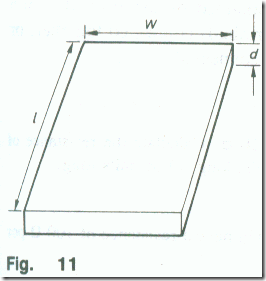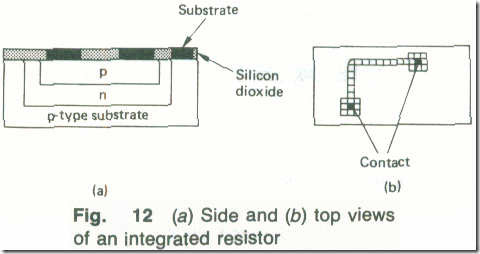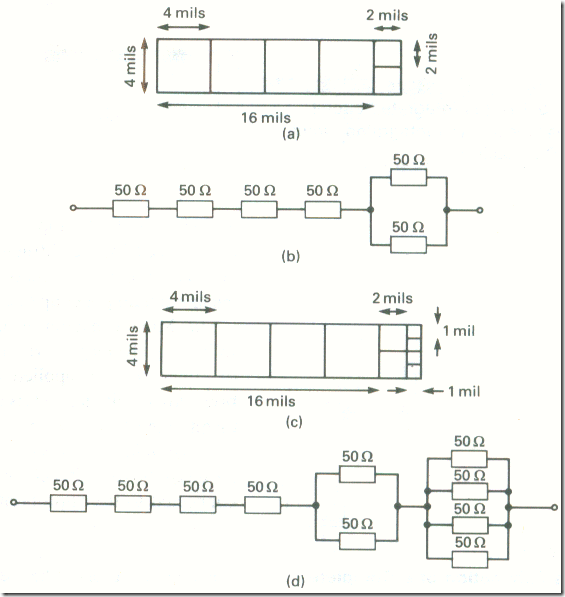Integrated Circuit Resistor
Integrated resistors are made using a thin layer of p-type silicon that is diffused at the same time as the base of the transistor. The resistance of a silicon layer depends on the length /, area a and resistivity p of the layer according to
The area a of the layer is the product of the width W and the depth d of the layer. Thus
R = ρƖ/Wd Ω
It is usual to express the resistance in terms of the resistance of a square of the silicon layer (Fig. 11) in which the width If of the layer is equal to the length Ɩ . Then, equation can be written as
The resistance is now the resistance between the opposite sides of a square and it is measured in a unit known as the ohm per square. The resistance depends only on the resistivity of the silicon layer and not on the dimensions of the square. The resistivity of the layer is determined by the number of charge carriers (holes) that are diffused into the layer and the depth to which they penetrate. However, since both of these variables are fixed by the requirements of the simultaneously diffused transistors, a required resistance value must be obtained by a suitable choice of the length and width of the resistive path. The resistance value given by a square can be increased by increasing the length of the path. Difficulties are experienced with the fabrication of very high values of resistance because of the relatively large chip area such resistances demand.
The constructional details of an integrated resistor are given in Figs. 12(a) and (b). Fig. 12(a) shows that the resistive path is formed by a p-type region that joins together the resistor contacts. A p-type path is used since it will be diffused at the same time as transistor base regions and will therefore be only lightly doped. The resistivity will therefore be in the range of 100-300 Ω/□. When very low values of resistance are required an n-type resistor is employed; the n-type path is diffused at the same time as the transistor emitter regions and will therefore be of much lower resistivity. Fig. 12(b) shows the top view of an integrated resistor and indicates how a required resistance value may be obtained by connecting in series a number of ‘squares’. The resistor can follow any path that will best utilize the surface area of the chip. The practical range of resistance values is from about 15 Ω to about 30 kΩ.
The tolerance of an IC resistor is rather poor, being of the order of 20%. Resistors formed in the same chip can be closely matched, certainly to within about 1 %. Since IC resistors take up a relatively large chip area their use within an IC is avoided as much as possible. A required resistance can often be obtained by using an IC n-p-n transistor with its base and emitter terminals connected together, or a FET with its gate and source interconnected.
Example I
The resistivity of a p-type region is 100 Ω/□. Calculate the resistance of a strip which is 1 mil wide and (i) 20 mils long (ii) 30 mils long.
Solution
Since the resistive strip is 1 mil wide it will have a resistance of 100 Ω per
1 mil length.
(i) The resistance of a 20 mil length is 20 x 100 = 2000 Ω (Ans)
(ii) The resistance of a 30 mil length is 30 x 100 = 3000 Ω (Ans)
Example 2
An 1C resistor is made up from a length of 4 mil wide resistive strip of resistivity 50Ω/□. Calculate its resistance if the strip is (a) 18 mils (b) 19 mils long.
Solution
(a) The resistor is equivalent to a 16 mil length of 4 mil wide strip plus two 2 X 2 mil squares, as shown by Fig. 13(a). The resistance of each is the same regardless of its dimensions. Hence, the equivalent circuit is as shown by Fig. 13(b). From this circuit the resistance R of the 1C resistor is 4 x 50 + 50/2 = 225 Ω (Ans.)
(b) The 19 mil long resistor is shown in Figs. 13(c) and (d). ft effectively consists of four 4×4 mils squares plus two 2×2 mil squares plus four 1 X 1 mil squares. The resistance K is
R = 4 x 50 + 50/2 + 50/4 = 237.5 Ω (Ans.)




